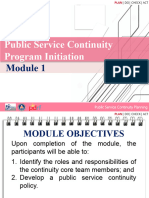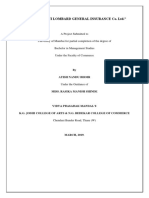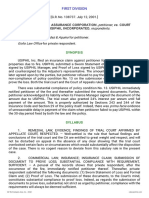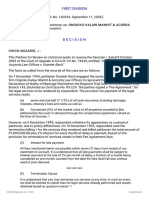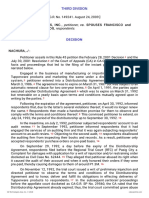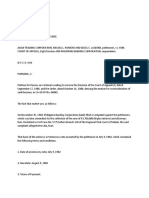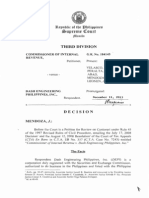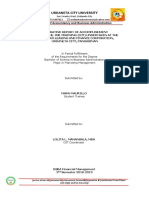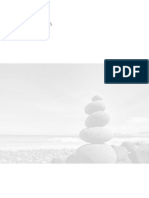Finman Vs CA and Usiphil
Finman Vs CA and Usiphil
Uploaded by
Ana AdolfoCopyright:
Available Formats
Finman Vs CA and Usiphil
Finman Vs CA and Usiphil
Uploaded by
Ana AdolfoOriginal Description:
Original Title
Copyright
Available Formats
Share this document
Did you find this document useful?
Is this content inappropriate?
Copyright:
Available Formats
Finman Vs CA and Usiphil
Finman Vs CA and Usiphil
Uploaded by
Ana AdolfoCopyright:
Available Formats
FIRST DIVISION
[G.R. No. 138737. July 12, 2001]
FINMAN GENERAL ASSURANCE CORPORATION, petitioner, vs. COURT OF APPEALS and USIPHIL INCORPORATED, respondents. DECISION KAPUNAN, J.: Through this petition for review on certiorari Finman General Assurance Corporation (petitioner) seeks to reverse and set aside the Decision, dated January 14, 1999, of the Court of Appeals (CA) in CA-G.R. CV No. 46721 directing petitioner to pay the insurance claim of Usiphil Incorporated (private respondent). The appellate courts Resolution, dated May 13, 1999, which denied petitioners motion for reconsideration, is likewise sought to be reversed and set aside. The antecedent facts, as culled from the decision of the trial court and the CA, are as follows: On September 15, 1981, private respondent obtained a fire insurance policy from petitioner (then doing business under the name Summa Insurance Corporation) covering certain properties, e.g., office, furniture, fixtures, shop machinery and other trade equipment. Under Policy No. F3100 issued to private respondent, petitioner undertook to indemnify private respondent for any damage to or loss of said properties arising from fire. Sometime in 1982, private respondent filed with petitioner an insurance claim amounting to P987,126.11 for the loss of the insured properties due to fire. Acting thereon, petitioner appointed Adjuster H.H. Bayne to undertake the valuation and adjustment of the loss. H.H. Bayne then required private respondent to file a formal claim and submit proof of loss. In compliance therewith, private respondent submitted its Sworn Statement of Loss and Formal Claim, dated July 22, 1982, signed by Reynaldo Cayetano, private respondents Manager. Respondent likewise submitted Proof of Loss signed by its Accounting Manager Pedro Palallos and countersigned by H.H. Baynes Adjuster F.C. Medina. Palallos personally followed-up private respondents claim with petitioners President Joaquin Ortega. During their meeting, Ortega instructed their Finance Manager, Rosauro Maghirang, to reconcile the records. Thereafter, Maghirang and Palallos signed a Statement/Agreement, dated February 28, 1985, which indicated that the amount due respondent was P842,683.40. Despite repeated demands by private respondent, petitioner refused to pay the insurance claim. Thus, private respondent was constrained to file a complaint against petitioner for the unpaid insurance claim. In its Answer, petitioner maintained that the claim of private respondent could not be allowed because it failed to comply with Policy Condition No. 13 regarding the submission of certain documents to prove the loss. Trial ensued. On July 6, 1994, the trial court rendered judgment in favor of private respondent. The dispositive portion of the decision reads: WHEREFORE, in view of the above observations and findings, judgment is hereby rendered in favor of the plaintiff and against the defendant, ordering the latter: 1. To pay the plaintiff the sum of P842,683.40 and to pay 24% interest per annum from February 28, 1985 until fully paid (par. 29 of Exh. K); 2. To pay the plaintiff the sum equivalent to 10% of the principal obligation as and for attorneys fees, plus P1,500.00 per cou rt appearance of counsel; 3. To pay the plaintiff the amount of P30,000.00 as exemplary damages in addition to the actual and compensatory damages awarded; 4. Dismissing the claim of P30,000.00 for actual damages under par. 4 of the prayer, since the actual damages has been awarded under par. 1 of the decisions dispositive portion; 5. Dismissing the claim of interest under par. 2 of the prayer, there being no agreement to such effect; 6. Dismissing the counter-claim for lack of merit;
7. Ordering the defendant to pay the cost of suit. SO ORDERED.[1] On appeal, the CA substantially affirmed the decision of the trial court. The dispositive portion of the CA decision reads: WHEREFORE, the appealed decision is hereby AFFIRMED with the modification that defendant-appellant is ordered to pay plaintiff-appellee the sum of P842,683.40 and to pay 24% interest per annum from 03 May 1985 until fully paid. In all other respects, the appealed decision is AFFIRMED IN TOTO. SO ORDERED.[2] Petitioner now comes to this Court assailing the decision of the appellate court. Petitioner alleges that: Respondent Court of Appeals erred in finding that there is evidence sufficient to justify the Decision of the lower court; Respondent Court of Appeals erred in failing to consider the fact that Private Respondent committed a violation of the Insurance Policy which justifies the denial of the claim by Petitioner; Respondent Court of Appeals further erred in finding that Petitioner is liable to pay the respondent, Usiphil, Inc., an interest of 24% per annum in addition to the principal amount of P842,683.40.[3] Essentially, petitioner argues that the disallowance of private respondents claim is justified by its failure to submit the required documents in accordance with Policy Condition No. 13. Said requirements were allegedly communicated to private respondent in the two letters of H.H. Bayne to private respondent. The first letter stated: To be able to expedite adjustment of this case, please submit to us without delay the following documents and/or particulars: For FFF, Machineries/Equipment Claims 1. Your formal claim (which may be accomplished in the enclosed form) accompanied by a detailed inventory of the documents submitted. 2. Certification from the appropriate government office indicating the date of the occurrence of the fire, the property involved, its location and possible point of origin. 3. Proof of premium payment. 4. Three color photographs of the debris properly captioned/identified/dated and initiated by the claimant at the back. 4.1 Close-up (not more than 2 meters away) of the most severely damaged. 4.2 Close-up (not more than 2 meters away) of the least damaged. 4.3. Original view of the debris (may be from farther than 2 meters away); splice two or more frames if necessary. Though our adjusters will also take photographs in the manner prescribed above, please do not rely on his photographs in the preservations of your evidence of loss thru pictures. 5. Copies of purchase invoices. 6. In the absence of No. 5, suppliers certificates of sales and delivery. 7. Appraisal report, if any. 8. Where initial estimated loss is exceeding P20,000.00, submit estimate by at least 2 contractors/suppliers.
9. Others (to be specified) 1. Repairs cost of the affected items including quotation or invoices in support thereof; 2. Complete lists of furniture, fixtures & fittings including date and cost of acquisition, and; 3. Statement of salvage on burned items. Your preferential attention to this request will be fully appreciated.[4] While the other letter stated: Please submit to us without delay the following documents and/or particulars. For Stock Claim 1. Your formal claim (which may be accomplished in the enclosed), accompanied by a detailed inventory of the documents submitted. 2. Certification from the appropriate government office showing that the Insureds property was involved in the fire as a consequence of which the claim is being filed. 3. Proof of premium payment. 4. Three colored photographs of the debris, property captioned/identified/dated and initiated by the claimant at the back; in a floor plan, indicate the point from where the picture was taken and by an arrow where the camera was facing. 4.1. Close-up (not more than 2 meters away) of the most severely damaged. 4.2. Close-up (not more than 2 meters away) of the least damaged. 4.3. Overall view of the debris (may be from farther than 2 meters away); splice two or more frames if necessary. Our adjuster will also take photographs. 5. Books of accounts bill, invoices and other vouchers, or certified copies thereof if originals be lost. This requirement includes, but is not limited to, purchase and sales invoices, delivery 6. Certified copies of income tax returns for the last three years and the accompanying financial statements. 7. Latest inventory of merchandise filed with a financial institution, the Bureau of Internal Revenue or any government entity prior to the loss. 8. A detailed inventory of the articles damaged or destroyed, showing the cost price of each, extent of loss, if any, if the risk sustained partial or water damaged. 9. Certificates of registration. 10. Bank Statements. 11. For losses where the estimated value of stocks claimed which are burned out of sight and/or which may no longer be subject to actual physical count exceeds P50,000.00, a CPAs detailed computations in support of such estimated value. 12. In the absence of purchase invoices/delivery receipts (state reason for absence), submit suppliers certificate of sales and delivery. 13. Others (to be specified).
Statement of salvage of the affected stocks in trade. Your compliance with this request will enable us to expedite adjustment of the loss in caption.[5] According to petitioner, in complete disregard of the foregoing requirements, private respondent never submitted any of the documents mentioned therein. Further, petitioner assails the award in favor of private respondent of an interest rate of 24% per annum. Since there was allegedly no express finding that petitioner unreasonably denied or withheld the payment of the subject insurance claim, then the award of 24% per annum is not proper. Petitioner opines that the judgment should only bear the legal interest rate of 12% per annum for the delay in the payment of the claim. The petition is bereft of merit. Well-settled is the rule that factual findings and conclusions of the trial court and the CA are entitled to great weight and respect, and will not be disturbed on appeal in the absence of any clear showing that the trial court overlooked certain facts or circumstances which would substantially affect the disposition of the case.[6]There is no cogent reason to deviate from this salutary rule in the present case. Both the trial court and the CA concur in holding that private respondent had substantially complied with Policy Condition No. 13 which reads: 13. The insured shall give immediate written notice to the Company of any loss, protect the property from further damage, forthwith separate the damaged and undamaged personal property, put it in the best possible order, furnish a complete inventory of the destroyed, damaged, and undamaged property, showing in detail quantities, costs, actual cash value and the amount of loss claimed; AND WITHIN SIXTY DAYS AFTER THE LOSS, UNLESS SUCH TIME IS EXTENDED IN WRITING BY THE COMPANY, THE INSURED SHALL RENDER TO THE COMPANY A PROOF OF LOSS, signed and sworn to by the insured, stating the knowledge and belief of the insured as to the following: the time and origin of the loss, the interest of the insured and of all others in the property, the actual cash value of each item thereof and the amount of loss thereto, all encumbrances thereon, all other contracts of insurance, whether valid or not, covering any of said property, any changes in the title, use, occupation, location, possession or exposures of said property since the issuing of this policy by whom and for what purpose any buildings herein described and the several parts thereof were occupied at the time of loss and whether or not it then stood on leased ground, and shall furnish a copy of all the descriptions and schedules in all policies, and if required verified plans and specifications of any building, fixtures, or machinery destroyed or damaged. The insured, as often as may be reasonably required, shall exhibit to any person designated by the company all that remains of any property herein described, and submit to examination under oath by any person named by the Company, and subscribe the same; and, as often as may be reasonably required, shall produce for examination all books of account, bills, invoices, and other vouchers or certified copies thereof if originals be lost, at such reasonable time and place as may be designated by the Company or its representative and shall permit extracts and copies thereof to be made. No claim under this policy shall be payable unless the terms of this condition have been complied with.[7] A perusal of the records shows that private respondent, after the occurrence of the fire, immediately notified petitioner thereof. Thereafter, private respondent submitted the following documents: (1) Sworn Statement of Loss and Formal Claim (Exhibit C) and; (2) Proof of Loss (Exhibit D). The submission of these documents, to the Courts mind, constitutes substantial compliance with the above provision. Indeed, as regards the submission of documents to prove loss, substantial, not strict as urged by petitioner, compliance with the requirements will always be deemed sufficient.[8] In any case, petitioner itself acknowledged its liability when through its Finance Manager, Rosauro Maghirang, it signed the document indicating that the amount due private respondent is P842,683.40 (Exhibit E). As correctly held by the appellate court: Under the aforequoted provision of the insurance policy, the insured was required to submit to the insurer written notice of the loss; and a complete inventory of the properties damaged within 60 days after the fire, as well as a signed and sworn statement of Proof of Loss. It is admitted by all parties that plaintiff-appellee notified the insurer Summa Corporation of the fire which occurred on 27 May 1982. It is likewise admitted by all parties that plaintiff-appellee submitted the following documents in support of its claim: (1) Sworn Statement of Loss (Exhibit C); (2) formal claim dated 22 July 1982; (3) unnotarized sworn statement of proof of loss (Exhibit D). There was, therefore, sufficient compliance with the requirements in Section 13 of the policy. But, even assuming that plaintiff-appellee indeed failed to submit certain required documents as proof of loss per Section 13, such violation was waived by the insurer Summa when it signed the document marked Exhibit E, a breakdown of the amount due to plaintiff-appellee as of February 1985 on the insurance claim. By such act, defendant-appellant acknowledged its liability under the insurance policy. Antecedent to the execution of Exhibit E, there was a conference between Pallalos, representing plaintiff-appellee and Ortega representing Summa Insurance. There is no evidence that in that meeting, Summa Insurance questioned plaintiff-appellees submission of the required documents. What happened was that Ortega summoned Maghirang so that he could settle with Pallalos regarding the amount due to plaintiffappellee from insurance claim. The result is a reconciliation of claim in Exhibit E which shows that as of February 1985, the net due sum is P842,683.49.
Defendant-appellant alleges that Maghirang was without authority to sign Exhibit E, and therefore without authority to bind defendantappellant corporation. We do not agree. The evidence indicate that at a meeting between plaintiff-appellees corporate president Pedro Pallalos and his counterpart in defendant-appellant corporation, Joaquin Ortega, the latter summoned Rosauro Maghirang to reconcile the claims of plaintiff-appellee. One who clothes another with apparent authority as his agent and holds him to the public as such, cannot later be allowed to deny the authority of such person to act as his agent when such third person entered into the contract in good faith and in an honest belief that he is such agent. Witness for defendant-appellant Luis Manapats testimony that Maghirang was without authority to bind the defendant-appellant cannot be given credence because, as he himself testified, he was not yet part of the Summa Corporation at the time the negotiations in question were going on.[9] Anent the payment of 24% interest per annum computed from May 3, 1985 until fully paid, suffice it to say that the same is authorized by Sections 243 and 244 of the Insurance Code: Sec. 243. The amount of any loss or damage for which an insurer may be liable, under any policy other than life insurance policy, shall be paid within thirty days after proof of loss is received by the insurer and ascertainment of the loss or damage is made either by agreement between the insured and the insurer or by arbitration; but if such ascertainment is not had or made within sixty days after such receipt by the insurer of the proof of loss, then the loss or damage shall be paid within ninety days after such receipt. Refusal or failure to pay the loss or damage within the time prescribed herein will entitle the assured to collect interest on the proceeds of the policy for the duration of the delay at the rate of twice the ceiling prescribed by the Monetary Board, unless such failure or refusal to pay is based on the ground that the claim is fraudulent. Sec. 244. In case of any litigation for the enforcement of any policy or contract of insurance, it shall be the duty of the Commissioner or the Court, as the case may be, to make a finding as to whether the payment of the claim of the insured has been unreasonably denied or withheld; and in the affirmative case, the insurance company shall be adjudged to pay damages w hich shall consist of attorneys fees and other expenses incurred by the insured person by reason of such unreasonable denial or withholding of payment plus interest of twice the ceiling prescribed by the Monetary Board of the amount of the claim due the insured, from the date following the time prescribed in section two hundred forty-two or in section two hundred forty-three, as the case may be, until the claim is fully satisfied: Provided, That the failure to pay any such claim within the time prescribed in said sections shall be considered prima facie evidence of reasonable delay in payment. Notably, under Section 244, a prima facie evidence of unreasonable delay in payment of the claim is created by the failure of the insurer to pay the claim within the time fixed in both Sections 243 and 244.[10] Further, Section 29 of the policy itself provides for the payment of such interest: 29. Settlement of claim clause. The amount of any loss or damage for which the company may be liable, under this policy shall be paid within thirty days after proof of loss is received by the company and ascertainment of the loss or damage is made either in an agreement between the insured and the company or by arbitration; but if such ascertainment is not had or made within sixty days after such receipt by the company of the proof of loss, then the loss or damage shall be paid within ninety days after such receipt. Refusal or failure to pay the loss or damage within the time prescribed herein will entitle the assured to collect interest on the proceeds of the policy for the duration of the delay at the rate of twice the ceiling prescribed by the Monetary Board, unless such failure or refusal to pay is based on the grounds (sic) that the claim is fraudulent.[11] The policy itself obliges petitioner to pay the insurance claim within thirty days after proof of loss and ascertainment of the loss made in an agreement between private respondent and petitioner. In this case, as found by the CA, petitioner and private respondent signed the agreement (Exhibit E) indicating that the amount due private respondent was P842,683.40 on April 2, 1985. Petitioner thus had until May 2, 1985 to pay private respondents insurance.[12] For its failure to do so, the CA and the trial court rightfully directed petitioner to pay, inter alia, 24% interest per annum in accordance with the above quoted provisions. WHEREFORE, the instant petition is hereby DENIED for lack of merit. The Decision, dated January 14, 1999, of the Court of Appeals in CA-G.R. CV No. 46721 and its Resolution, dated May 13, 1999, are AFFIRMED IN TOTO. SO ORDERED. Davide, Jr., C.J., (Chairman), Puno, Pardo, and Ynares-Santiago, JJ., concur.
You might also like
- Day 2 - Module 1 Public Service Continuity Program Initiation - 2021-03!30!05!51!02-PmDocument45 pagesDay 2 - Module 1 Public Service Continuity Program Initiation - 2021-03!30!05!51!02-PmQPDRRMO RAP 3100% (1)
- Study in ICICI LombardDocument64 pagesStudy in ICICI LombardDebabrato SasmalNo ratings yet
- Icici Bank Rar 2013Document40 pagesIcici Bank Rar 2013Moneylife Foundation50% (2)
- Hotel PreOpening Accounting ChecklistDocument27 pagesHotel PreOpening Accounting ChecklistDeo Patria Herdrianto100% (1)
- 72-Finman Assurance Corporation vs. Court of Appeals, 361 SCRA 514 (2001)Document7 pages72-Finman Assurance Corporation vs. Court of Appeals, 361 SCRA 514 (2001)Jopan SJNo ratings yet
- Finman General Assurance v. CADocument13 pagesFinman General Assurance v. CAMelissa AdajarNo ratings yet
- Petitioner Vs Vs Respondents Saludo Agpalo Fernandez & Aquino Goño Law OfficeDocument9 pagesPetitioner Vs Vs Respondents Saludo Agpalo Fernandez & Aquino Goño Law OfficeEishrine AmanteNo ratings yet
- Bach v. Ongkiko Kalaw Manhit Acorda LawDocument10 pagesBach v. Ongkiko Kalaw Manhit Acorda LawDayle ManlodNo ratings yet
- 76 FT Bach Vs Ongkiko Kalaw Manhit & Acorda Law OfficesDocument6 pages76 FT Bach Vs Ongkiko Kalaw Manhit & Acorda Law OfficesIamIvy Donna PondocNo ratings yet
- Zenith Insurance v. CADocument4 pagesZenith Insurance v. CAMICAELA NIALANo ratings yet
- G.R. No. 138131 - Solid Bank V CADocument6 pagesG.R. No. 138131 - Solid Bank V CAmctc.galimuyodNo ratings yet
- (2-1) Bach - v. - Ongkiko - Kalaw - Manhit - Acorda - LawDocument10 pages(2-1) Bach - v. - Ongkiko - Kalaw - Manhit - Acorda - LawJinnelyn LiNo ratings yet
- Decision Panganiban, J.:: Oriental Assurance Corporation, Petitioner, vs. Solidbank Corporation, RespondentDocument7 pagesDecision Panganiban, J.:: Oriental Assurance Corporation, Petitioner, vs. Solidbank Corporation, RespondentSi KayeNo ratings yet
- Petitioner Vs Vs Respondents: Third DivisionDocument9 pagesPetitioner Vs Vs Respondents: Third DivisionJohn Paul SuaberonNo ratings yet
- G.R. No. 149241 August 24, 2009 DART PHILIPPINES, INC., Petitioner, Spouses Francisco and Erlinda Calogcog, RespondentsDocument42 pagesG.R. No. 149241 August 24, 2009 DART PHILIPPINES, INC., Petitioner, Spouses Francisco and Erlinda Calogcog, RespondentsnellafayericoNo ratings yet
- First Division (G.R. NO. 160334, September 11, 2006) Guenter Bach, Petitioner, vs. Ongkiko Kalaw Manhit & Acorda LAW Offices, Respondent. DecisionDocument9 pagesFirst Division (G.R. NO. 160334, September 11, 2006) Guenter Bach, Petitioner, vs. Ongkiko Kalaw Manhit & Acorda LAW Offices, Respondent. DecisionjwualferosNo ratings yet
- Florentino Vs SuperValue - FullDocument4 pagesFlorentino Vs SuperValue - FullJomz ArvesuNo ratings yet
- Finman General Assurance v. CADocument3 pagesFinman General Assurance v. CALance LagmanNo ratings yet
- Supreme Court: Vicente R. Layawen For Petitioner. Lawrence L. Fernandez & Associates For Private RespondentDocument5 pagesSupreme Court: Vicente R. Layawen For Petitioner. Lawrence L. Fernandez & Associates For Private RespondentPebs DrlieNo ratings yet
- G.R. No. 85296 May 14, 1990 Zenith Insurance Corporation, Petitioner, Court of Appeals and Lawrence Fernandez, Respondents. Medialdea, J.Document4 pagesG.R. No. 85296 May 14, 1990 Zenith Insurance Corporation, Petitioner, Court of Appeals and Lawrence Fernandez, Respondents. Medialdea, J.yangkee_17No ratings yet
- Trust International Paper Corporation vs. Marilou R. PelaezDocument10 pagesTrust International Paper Corporation vs. Marilou R. Pelaezjafernand100% (1)
- Asian Trading Corp vs. CADocument9 pagesAsian Trading Corp vs. CAAlexander Julio ValeraNo ratings yet
- LARA'S GIFTS & DECORS, INC., vs. MIDTOWN INDUSTRIAL SALES, INC.Document10 pagesLARA'S GIFTS & DECORS, INC., vs. MIDTOWN INDUSTRIAL SALES, INC.5j269c9w49No ratings yet
- Estanislao v. EastwestDocument4 pagesEstanislao v. EastwestheyoooNo ratings yet
- G.R. No. 161904. Asian Construction vs. TulabutDocument5 pagesG.R. No. 161904. Asian Construction vs. TulabutMannor ModaNo ratings yet
- Eternal Gardens vs. PhilamlifeDocument11 pagesEternal Gardens vs. PhilamlifeRishel TubogNo ratings yet
- Idos V CaDocument10 pagesIdos V CaMicah Clark-MalinaoNo ratings yet
- 4 Zenith Insurance Vs FernandezDocument4 pages4 Zenith Insurance Vs FernandezCases M7No ratings yet
- COMMERCIAL LAW 1 - Lara's Gifts Decors Inc. v. MidtownDocument72 pagesCOMMERCIAL LAW 1 - Lara's Gifts Decors Inc. v. Midtownsinodingjr nuskaNo ratings yet
- Abrenica Vs AbrenicaDocument18 pagesAbrenica Vs AbrenicaThina Chii0% (1)
- Claim Form - Debra CunningDocument6 pagesClaim Form - Debra Cunningtreshann.burrellNo ratings yet
- Full Text - CalimlimDocument25 pagesFull Text - CalimlimRomnick JesalvaNo ratings yet
- Civpro Rules 1 4Document326 pagesCivpro Rules 1 4jpoy61494No ratings yet
- 04-Zenith Insurance Corporation vs. Court of Appeals and Lawrence Fernandez, G.R. No. 85296, 14 May 1990Document4 pages04-Zenith Insurance Corporation vs. Court of Appeals and Lawrence Fernandez, G.R. No. 85296, 14 May 1990Jopan SJNo ratings yet
- 19 Citibank NA Mastercard V TeodoroDocument8 pages19 Citibank NA Mastercard V TeodoroFrances Angelica Domini KoNo ratings yet
- Supreme Court: Today Is Saturday, September 24, 2016Document5 pagesSupreme Court: Today Is Saturday, September 24, 2016Audrey DeguzmanNo ratings yet
- Idos Versus Court of AppealsDocument14 pagesIdos Versus Court of AppealsSharmen Dizon Gallenero0% (1)
- Integrated Corp Vs CADocument4 pagesIntegrated Corp Vs CAMaria GinalynNo ratings yet
- EncaDocument5 pagesEncaLDCNo ratings yet
- Credit KasoDocument13 pagesCredit KasoGarri AtaydeNo ratings yet
- Full CaseDocument6 pagesFull CaseLara ConcepcionNo ratings yet
- RCBC and Kudos PDFDocument26 pagesRCBC and Kudos PDFJohn Paul Pagala AbatNo ratings yet
- Servicewide Specialists Inc Vs Intermediate Appellate CourtDocument6 pagesServicewide Specialists Inc Vs Intermediate Appellate CourtJunalyn BuesaNo ratings yet
- G.R. No. 85296Document3 pagesG.R. No. 85296jeffdelacruzNo ratings yet
- American Home Insurance V ChuaDocument7 pagesAmerican Home Insurance V ChuaMaria Cristina MartinezNo ratings yet
- Arwood Industries Vs DM ConsunjiDocument9 pagesArwood Industries Vs DM Consunjidominicci2026No ratings yet
- Eternal Gardens Memorial G.R. No. 166245 Park Corporation,: Republic of The Philippines Supreme Court Baguio CityDocument13 pagesEternal Gardens Memorial G.R. No. 166245 Park Corporation,: Republic of The Philippines Supreme Court Baguio CityRomel LacidaNo ratings yet
- 7) Abrenica V Abrenica, G.R. No. 169420Document6 pages7) Abrenica V Abrenica, G.R. No. 169420Suelyn JumalaNo ratings yet
- CBL Project-1-1Document10 pagesCBL Project-1-1VIJAY VARADHARAJNo ratings yet
- 1245-1250 CasesDocument35 pages1245-1250 CasesMarry SuanNo ratings yet
- Civil Pro DigestDocument6 pagesCivil Pro DigestaeronastyNo ratings yet
- 117070-2007-Casent Realty Development Corp. v.20181017-5466-h6jvksDocument7 pages117070-2007-Casent Realty Development Corp. v.20181017-5466-h6jvksSeok Gyeong KangNo ratings yet
- Cta 2D CV 10517 R 2023may18 AssDocument14 pagesCta 2D CV 10517 R 2023may18 AssgregmanilaNo ratings yet
- Prulife Vs CirDocument12 pagesPrulife Vs CirERWINLAV2000No ratings yet
- G.R. No. 85296Document4 pagesG.R. No. 85296Hanifa D. Al-ObinayNo ratings yet
- Second Division (G.R. NO. 135149, July 25, 2006)Document4 pagesSecond Division (G.R. NO. 135149, July 25, 2006)JB AndesNo ratings yet
- Active Realty & Development Corporation, Petitioner, Daroya-Quinones, RespondentsDocument6 pagesActive Realty & Development Corporation, Petitioner, Daroya-Quinones, RespondentsGH IAYAMAENo ratings yet
- Qcourt: 3republic of Tbe LlbilippinesDocument10 pagesQcourt: 3republic of Tbe LlbilippinesThe Supreme Court Public Information Office100% (1)
- VICTORINA ALICE LIM LAZARO v. BREWMASTER INTERNATIONALDocument7 pagesVICTORINA ALICE LIM LAZARO v. BREWMASTER INTERNATIONALKhate AlonzoNo ratings yet
- 14 Sunga-Chan v. Court of Appeals, G.R. No. 164401, 25 June 2008Document15 pages14 Sunga-Chan v. Court of Appeals, G.R. No. 164401, 25 June 2008Hanelizan Ert RoadNo ratings yet
- Caltex V IACDocument6 pagesCaltex V IACAra Lorrea MarquezNo ratings yet
- A Guide to District Court Civil Forms in the State of HawaiiFrom EverandA Guide to District Court Civil Forms in the State of HawaiiNo ratings yet
- California Supreme Court Petition: S173448 – Denied Without OpinionFrom EverandCalifornia Supreme Court Petition: S173448 – Denied Without OpinionRating: 4 out of 5 stars4/5 (1)
- Petition for Certiorari Denied Without Opinion: Patent Case 98-1972.From EverandPetition for Certiorari Denied Without Opinion: Patent Case 98-1972.No ratings yet
- Manufacturers Life Insurance Vs MeerDocument4 pagesManufacturers Life Insurance Vs MeerAna AdolfoNo ratings yet
- Rodolfo M. Morelos For Petitioner. Ferrer, Mariano, Sangalang & Gatdula For Private RespondentDocument3 pagesRodolfo M. Morelos For Petitioner. Ferrer, Mariano, Sangalang & Gatdula For Private RespondentAna AdolfoNo ratings yet
- Gsis VS Ca 1999Document5 pagesGsis VS Ca 1999Ana AdolfoNo ratings yet
- Bpi VS PosadasDocument4 pagesBpi VS PosadasAna AdolfoNo ratings yet
- First QC VS CaDocument3 pagesFirst QC VS CaAna AdolfoNo ratings yet
- Gelos VS CaDocument3 pagesGelos VS CaAna AdolfoNo ratings yet
- Brent School Vs Zamora 1990Document3 pagesBrent School Vs Zamora 1990Ana AdolfoNo ratings yet
- Natalia Realty Vs DarDocument7 pagesNatalia Realty Vs DarAna AdolfoNo ratings yet
- Busorg Digest Arbes Vs PolisticoDocument2 pagesBusorg Digest Arbes Vs PolisticoAna Adolfo100% (2)
- Bastida Vs MenziDocument2 pagesBastida Vs MenziAna AdolfoNo ratings yet
- Bus Org Cases 3 5 6 13Document5 pagesBus Org Cases 3 5 6 13Ana AdolfoNo ratings yet
- BusOrg Digest TORRES Vs CADocument2 pagesBusOrg Digest TORRES Vs CAAna Adolfo75% (4)
- Gatchalian Vs CirDocument1 pageGatchalian Vs CirAna AdolfoNo ratings yet
- APPEALS, Respondents. G.R. No. L-9996 October 15, 1957Document9 pagesAPPEALS, Respondents. G.R. No. L-9996 October 15, 1957Ana AdolfoNo ratings yet
- Matabuena Vs CervantesDocument3 pagesMatabuena Vs CervantesAna AdolfoNo ratings yet
- Matabuena Vs CervantesDocument3 pagesMatabuena Vs CervantesAna AdolfoNo ratings yet
- Augustinine 10 CommandmentsDocument1 pageAugustinine 10 CommandmentsAna AdolfoNo ratings yet
- Fraud in The Factum Is A Type ofDocument5 pagesFraud in The Factum Is A Type ofAna Adolfo100% (1)
- Quality Management For The Medical Laboratory: Michael Noble MD FRCPCDocument26 pagesQuality Management For The Medical Laboratory: Michael Noble MD FRCPCFarhan SyedNo ratings yet
- OM Hewlett Packard CaseDocument10 pagesOM Hewlett Packard Casematt_dellinger12No ratings yet
- Travel Claim Form Sept 2019 LastDocument2 pagesTravel Claim Form Sept 2019 LastWílSon ARmando Suriar Ws100% (1)
- Britam ContractsDocument3 pagesBritam ContractsKevin SantosNo ratings yet
- Scribd For Entrepreneurs: A Blueprint For Business SuccessDocument2 pagesScribd For Entrepreneurs: A Blueprint For Business SuccessABDESSALEM AGHRIBNo ratings yet
- OAM 11 - Q2 - 0901 - SG - Small Business Management and EntrepreneurshipDocument24 pagesOAM 11 - Q2 - 0901 - SG - Small Business Management and EntrepreneurshipaiccateducNo ratings yet
- May-22Document2 pagesMay-22jaya srivastavaNo ratings yet
- IT Project Manager Resume - Sample 1: Sharad SaxenaDocument20 pagesIT Project Manager Resume - Sample 1: Sharad SaxenaSrikanth MarneniNo ratings yet
- Es I Sap Admin GuideDocument110 pagesEs I Sap Admin GuideGuruprasad Tiptur Nagaraja0% (1)
- Concreso Ponencia ConnartDocument310 pagesConcreso Ponencia ConnartAnchel SalkNo ratings yet
- Vimesh Ticket DL To CH 0906Document1 pageVimesh Ticket DL To CH 0906KAUSTUBH PEDNEKARNo ratings yet
- GROUP 7 Chapter 13Document29 pagesGROUP 7 Chapter 13Rhad Lester C. MaestradoNo ratings yet
- Mahasti MotamedDocument2 pagesMahasti Motamedapi-121345256No ratings yet
- Toothpaste and Soaps ProjectDocument13 pagesToothpaste and Soaps ProjectAnkita123456780% (4)
- The Future: Now Streaming: KPMG - Ficci Indian Media and Entertainment Industry Report 2016Document13 pagesThe Future: Now Streaming: KPMG - Ficci Indian Media and Entertainment Industry Report 2016Santanu RoychoudhuryNo ratings yet
- EN - RO GlossaryDocument4,905 pagesEN - RO Glossaryioana_abrahanNo ratings yet
- Terms of PaymentDocument7 pagesTerms of Paymentyogita2003bangarNo ratings yet
- BPSM AssignmentDocument6 pagesBPSM AssignmentGarima GuptaNo ratings yet
- The Microstructure of The Euro - Phillipp HartmannDocument86 pagesThe Microstructure of The Euro - Phillipp HartmannmirceglavniNo ratings yet
- Nestlé's Nescafe International Advertising Strategy: Argentina Germany United StatesDocument18 pagesNestlé's Nescafe International Advertising Strategy: Argentina Germany United StateslohanasamajnisevaNo ratings yet
- Urdaneta City University: College of Accountancy and Business AdministrationDocument46 pagesUrdaneta City University: College of Accountancy and Business Administrationmara maurilloNo ratings yet
- Liechtenstein Bankers Association - Annual Report 2006Document30 pagesLiechtenstein Bankers Association - Annual Report 2006filimon100% (2)
- F45 Asia Tier 2 BrochureDocument22 pagesF45 Asia Tier 2 BrochureAdrian Kurnia100% (1)
- TechnipFMC Signs A Major Contract With MIDOR For Their Refinery Expansion and Modernization in EgyptDocument2 pagesTechnipFMC Signs A Major Contract With MIDOR For Their Refinery Expansion and Modernization in Egyptmuhammad ilyasNo ratings yet
- Australasian Marketing Journal - Volume 13 - Number 2 - 2005Document78 pagesAustralasian Marketing Journal - Volume 13 - Number 2 - 2005Arsyad BahaNo ratings yet
- Supreme Court: Custom SearchDocument5 pagesSupreme Court: Custom SearchJairus RubioNo ratings yet
